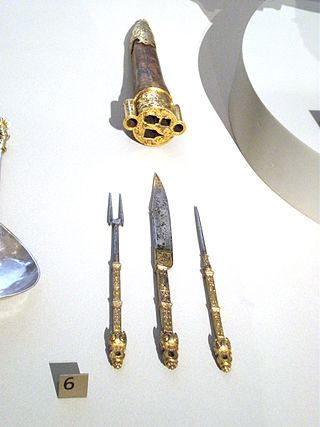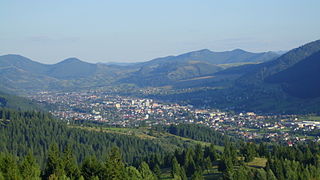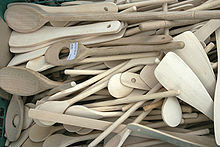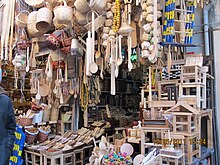
A spoon is a utensil consisting of a shallow bowl, oval or round, at the end of a handle. A type of cutlery, especially as part of a place setting, it is used primarily for transferring food to the mouth. Spoons are also used in food preparation to measure, mix, stir and toss ingredients and for serving food. Present day spoons are made from metal, wood, porcelain or plastic. There are a wide variety of spoons that are made of a variety of materials and by different cultures for many different uses and foods.

In cutlery or kitchenware, a fork is a utensil, now usually made of metal, whose long handle terminates in a head that branches into several narrow and often slightly curved tines with which one can spear foods either to hold them to cut with a knife or to lift them to the mouth.

Wood carving is a form of woodworking by means of a cutting tool (knife) in one hand or a chisel by two hands or with one hand on a chisel and one hand on a mallet, resulting in a wooden figure or figurine, or in the sculptural ornamentation of a wooden object. The phrase may also refer to the finished product, from individual sculptures to hand-worked mouldings composing part of a tracery.

Cutlery includes any hand implement used in preparing, serving, and especially eating food in Western culture. A person who makes or sells cutlery is called a cutler. The city of Sheffield in England has been famous for the production of cutlery since the 17th century and a train – the Master Cutler – running from Sheffield to London was named after the industry. Bringing affordable cutlery to the masses, stainless steel was developed in Sheffield in the early 20th century.

Various customary etiquette practices exist regarding the placement and use of eating utensils in social settings. These practices vary from culture to culture. Fork etiquette, for example, differs in Europe, the United States, and Southeast Asia, and continues to change. In East Asian cultures, a variety of etiquette practices govern the use of chopsticks.

Tableware items are the dishware and utensils used for setting a table, serving food, and dining. The term includes cutlery, glassware, serving dishes, serving utensils, and other items used for practical as well as decorative purposes. The quality, nature, variety and number of objects varies according to culture, religion, number of diners, cuisine and occasion. For example, Middle Eastern, Indian or Polynesian food culture and cuisine sometimes limits tableware to serving dishes, using bread or leaves as individual plates, and not infrequently without use of cutlery. Special occasions are usually reflected in higher quality tableware.

Câmpulung Moldovenesc is a city in Suceava County, northeastern Romania. It is situated in the historical region of Bukovina.
A lovespoon is a wooden spoon decoratively carved that was traditionally presented as a gift of romantic intent. The spoon is normally decorated with symbols of love, and was intended to reflect the skill of the carver. Due to the intricate designs, lovespoons are no longer used as functioning spoons and are now decorative craft items.

Table manners are the rules of etiquette used while eating, which may also include the use of utensils. Different cultures observe different rules for table manners. Each family or group sets its own standards for how strictly these rules are to be followed.
Vasile Hutopila is a contemporary Romanian painter of Ukrainian ethnicity. His works belong to impressionism.
The 1953 Divizia A was the thirty-sixth season of Divizia A, the top-level football league of Romania.

The Ifugao people are the ethnic group inhabiting Ifugao province in the Philippines. They reside in the municipalities of Lagawe, Aguinaldo, Alfonso Lista, Asipulo, Banaue, Hingyon, Hungduan, Kiangan, Lamut, Mayoyao, and Tinoc. The province is one of the smallest provinces in the Philippines with an area of only 251,778 hectares, or about 0.8% of the total Philippine land area. As of 1995, the population of the Ifugaos was counted to be 131,635. Although the majority of them are still in Ifugao province, some of them have moved to Baguio, where they work as woodcarvers, and to other parts of the Cordillera Region.

Chopsticks are shaped pairs of equal-length sticks that have been used as kitchen and eating utensils in most of East Asia for over three millennia. They are held in the dominant hand, secured by fingers, and wielded as extensions of the hand, to pick up food.

Bulul, also known as bul-ul or tinagtaggu, is a carved wooden figure used to guard the rice crop by the Ifugao peoples of northern Luzon.
The Frasin–Gura Humorului gas field is a natural gas field located in Gura Humorului, Suceava County, Romania. Discovered in 1971, it was developed by Romgaz, beginning production of natural gas and condensates in 1972. By 2010 the total proven reserves of the Frasin–Gura Humorului gas field were around 36 billion ft3 (1 km3), with a production rate of around 4.9 million ft3/day (0.14×105 m3). By January 2017, the Frasin–Gura Humorului gas field had a cumulative production of 1,680×106 m3 (5.9×1010 cu ft) of natural gas and 177×106 m3 (6.3×109 cu ft) of condensates, with its proven reserves down to 2,182×106 m3 (7.71×1010 cu ft) of natural gas and 520×106 m3 (1.8×1010 cu ft) of condensates, estimated to last until 2029.

Kamayan is a Filipino cultural term for the various occasions or contexts in which pagkakamay is practiced, including as part of communal feasting. Such feasts traditionally served the food on large leaves such as banana or breadfruit spread on a table, with the diners eating from their own plates. The practice is also known as kinamot or kinamut in Visayan languages.

Câmpulung County is one of the historic counties of the Kingdom of Romania, in the historical region of Bukovina. The county seat was Câmpulung Moldovenesc.


















